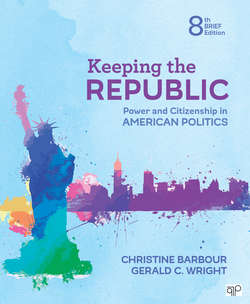Читать книгу Keeping the Republic - Christine Barbour - Страница 106
На сайте Литреса книга снята с продажи.
What Does the Constitution Say?
ОглавлениеNo single section of the Constitution deals with federalism. Instead, the provisions dividing power between the states and the national government appear throughout the Constitution. As a state matter, local government is not mentioned in the Constitution at all. Most of the Constitution is concerned with establishing the powers of the national government. Since Congress is the main lawmaking arm of the national government, many of the powers of the national government are the powers of Congress. The strongest statement of national power is a list of the enumerated powers of Congress (Article I, Section 8). This list is followed by a clause that gives Congress the power to make all laws that are “necessary and proper” to carry out its powers. The necessary and proper clause has been used to justify giving Congress many powers never mentioned in the Constitution. National power is also based on the supremacy clause of Article VI, which says that the Constitution and laws made in accordance with it are “the supreme law of the land.” This means that when national and state laws conflict, the national laws will be followed. The Constitution also sets limitations on the national government. Article I, Section 9, lists specific powers not granted to Congress, and the Bill of Rights (the first ten amendments to the Constitution) limits the power of the national government over individuals.
enumerated powers of Congress congressional powers specifically named in the Constitution (Article I, Section 8)
necessary and proper clause constitutional authorization for Congress to make any law required to carry out its powers
supremacy clause constitutional declaration (Article VI) that the Constitution and laws made under its provisions are the supreme law of the land
The Constitution says considerably less about the powers granted to the states. The Tenth Amendment says that all powers not given to the national government are reserved to the states, although the necessary and proper clause makes it difficult to see which powers are withheld from the national government. The states are given the power to approve the Constitution itself and any amendments to it. The Constitution also limits state powers. Article I, Section 10, denies the states certain powers, mostly the kinds that they possessed under the Articles of Confederation. The Fourteenth Amendment limits the power of the states over individual liberties, essentially a Bill of Rights that protects individuals from state action, since the first ten amendments apply only to the national government.
What these constitutional provisions mean is that the line between the national government and the state governments is not clearly drawn. We can see from Figure 3.1 that the Constitution designates specific powers as national, state, or concurrent. Concurrent powers are those that both levels of government may exercise. But the federal relationship is a good deal more complex than this chart would lead us to believe. The Supreme Court has become crucial to establishing the exact limits of provisions such as the necessary and proper clause, the supremacy clause, the Tenth Amendment, and the Fourteenth Amendment. This interpretation has changed over time, especially as historical demands have forced the Court to think about federalism in new ways.
concurrent powers powers that are shared by the federal and state governments
Description
Figure 3.1 The Constitutional Division of Powers Between the National Government and the States
